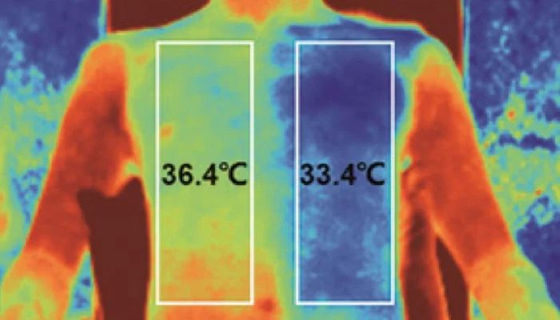Introducing clothes that have a skin temperature 5 degrees lower than cotton shirts just by wearing them, a new material that absorbs body heat and releases it to the outside

On July 8, 2021, researchers at Huazhong University of Science and Technology in China announced a new material that can lower body temperature by as much as 5 degrees compared to clothes made of ordinary fibers. This newly developed fiber is said to be able to release body heat to the outside and cool the body by reflecting infrared rays that are difficult to be absorbed by the surrounding atmosphere.
Hierarchical-morphology metafabric for scalable passive daytime radiative cooling | Science
New'mirror' fabric can cool wearers by nearly 5 ° C | Science | AAAS
https://www.sciencemag.org/news/2021/07/new-mirror-fabric-can-cool-wearers-nearly-5-c
New'Metafabric' Passively Cools The Human Body by Almost 5 Degrees Celsius
https://www.sciencealert.com/new-metafabric-could-passively-cool-the-human-body-by-almost-5-degrees-celsius
Smart fabric radiates heat to keep you cooler in the sun | New Scientist
https://www.newscientist.com/article/2283614-smart-fabric-radiates-heat-to-keep-you-cooler-in-the-sun/
Many people wear light-colored clothing to protect themselves from the sun. This has the effect of reflecting visible light and near-infrared rays to prevent the body temperature from rising, but the near-infrared rays are absorbed by water molecules and heat the air around the body, so the cooling effect is insignificant. It will be.
Therefore, researchers at Huazhong University of Science and Technology have developed fibers made by applying titanium oxide nanoparticles to polylactic acid and synthetic fibers and covering them with a thin film of polytetrafluoroethylene. This fabric looks like a normal white cloth, but it has the function of reflecting not only visible light and ultraviolet rays, but also mid-infrared rays, which are less easily absorbed by water molecules than near-infrared rays.

To test the effectiveness of this fiber, the research team created a vest, half made of a new material and half made of cotton, worn by volunteer graduate students and spent an hour in direct sunlight. It was. And as a result of measuring the best temperature with a thermal camera, the temperature of the right half of the new material is 33.4 degrees, and the other half of the commercially available cotton is 36.4 degrees, which is a difference of 3 degrees. .. Furthermore, when the temperature of the skin was measured with a temperature sensor attached to the back of the vest, the skin under the cotton rose from 31 degrees to 37 degrees after being in the hot sun for 1 hour, while the skin under the new material Only rose to 32 degrees, resulting in a difference of 5 degrees.

Also, in an experiment using a car left under the scorching sun, when the car was covered with a new material, the temperature was about 30 degrees higher than that of a car without a cover and about 27 degrees higher than that of a car using a commercially available car cover. It seems that the result that is low is obtained.
According to the research team, this new material can be processed into clothes with the same equipment as ordinary fibers, and the manufacturing cost is only about 10% higher than general clothes. From this, the research team said in a paper, 'Experimental results with a new material show great potential for various applications such as smart textiles, sunblock products, logistics fields, etc. We can expect that clothes made of new materials will be on the market in the near future.
Related Posts:
in Science, Posted by log1l_ks







